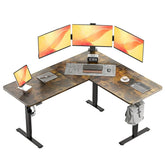The Environmental Impact of Standing Desks: Eco-Friendly Options
As sustainability becomes a core value for consumers and businesses alike, the demand for eco-friendly office furniture—including standing desks—has surged. Traditional desk manufacturing often relies on resource-intensive materials and energy-heavy processes, but a new generation of sustainable standing desks is changing the game. These desks prioritize renewable materials, responsible production, and reduced carbon footprints, proving that ergonomic health and environmental health can go hand in hand.
Bamboo standing desks have emerged as a leading eco-friendly choice, and for good reason. Bamboo is one of the fastest-growing plants on Earth, with some species reaching maturity in just 3–5 years—compared to 20–30 years for hardwood trees like oak or maple. It requires no pesticides or fertilizers to thrive and regenerates naturally from its root system after harvesting, eliminating the need for replanting. This rapid growth and minimal environmental impact make bamboo a highly renewable resource, far more sustainable than traditional wood.
Beyond its renewability, bamboo offers impressive durability. When processed into desk surfaces, it becomes hard, scratch-resistant, and comparable in strength to hardwoods. Many bamboo desks feature a natural, light-toned finish that adds warmth to workspaces, while others offer stained options for a more modern look. Look for desks made from 100% bamboo or bamboo plywood (layers of bamboo bonded with eco-friendly adhesives) to ensure authenticity—some products labeled "bamboo" may contain only a small percentage mixed with other woods.

Reclaimed wood standing desks are another sustainable option, combining environmental responsibility with unique aesthetic appeal. Reclaimed wood comes from old barns, factories, warehouses, or demolished buildings, giving new life to materials that would otherwise end up in landfills. Using reclaimed wood reduces the demand for newly harvested timber, preserving forests and reducing deforestation. Each reclaimed wood desk tells a story, with natural imperfections—like nail holes, weathered marks, or unique grain patterns—that add character and charm.
When shopping for reclaimed wood desks, inquire about the wood’s origin and processing. Reputable manufacturers should be transparent about where the wood comes from and how it’s been treated. Look for desks that use non-toxic, water-based finishes to avoid harmful chemicals, and ensure the wood is properly dried and stabilized to prevent warping over time. While reclaimed wood desks may come with a higher price tag due to the labor-intensive process of sourcing and preparing the wood, their sustainability and uniqueness make them a worthwhile investment for eco-conscious buyers.
Certifications play a crucial role in identifying truly sustainable standing desks. The Forest Stewardship Council (FSC) certification is the gold standard for wood products, ensuring that wood comes from responsibly managed forests that protect biodiversity, indigenous rights, and ecosystem health. FSC-certified standing desks may use hardwoods like oak or cherry, but their certification guarantees that the wood is harvested in a way that balances environmental, social, and economic needs.
Other relevant certifications include GREENGUARD and GREENGUARD Gold, which verify that products meet strict chemical emissions standards, reducing indoor air pollution. The Sustainable Furnishings Council (SFC) membership is another indicator of a brand’s commitment to sustainability, as members adhere to ethical sourcing and manufacturing practices. When comparing desks, look for these certifications to ensure your purchase aligns with your environmental values.

Eco-friendly manufacturing processes are just as important as sustainable materials. Many green standing desk brands prioritize energy efficiency in their factories, using solar power or other renewable energy sources to reduce reliance on fossil fuels. They also minimize waste by recycling manufacturing byproducts and using recyclable or biodegradable packaging. Some companies even offer take-back programs, ensuring that old desks are recycled or repurposed at the end of their lifecycle, preventing them from contributing to landfill waste.
Low-VOC (volatile organic compound) finishes and adhesives are essential features of eco-friendly standing desks. Traditional paints, stains, and glues release harmful VOCs into the air, contributing to indoor air pollution and potential health risks like headaches, respiratory issues, and eye irritation. Water-based finishes and formaldehyde-free adhesives eliminate these risks, creating healthier workspaces while reducing environmental harm. These safer alternatives perform as well as traditional options, offering durability and resistance to wear without the toxic side effects.
Electric standing desks, while convenient, can have a higher environmental impact due to their motorized components. However, eco-conscious brands are addressing this by using energy-efficient motors that consume less electricity during adjustment. Some models also feature auto-shutoff functions that power down the motor when not in use, further reducing energy consumption. For those seeking the lowest carbon footprint, manual standing desks (operated by crank or lever) require no electricity at all, making them a highly sustainable choice—though they may be less convenient for frequent height changes.
The environmental benefits of sustainable standing desks extend beyond their materials and manufacturing. By investing in a durable, long-lasting desk, you reduce the need for frequent replacements, which in turn reduces waste and resource consumption. High-quality eco-friendly desks are built to last 10–15 years or more, outperforming cheaper, less sustainable models that may need replacement every 3–5 years. This longevity makes them a cost-effective choice in the long run, despite potentially higher upfront costs.
For businesses looking to reduce their environmental impact, outfitting offices with eco-friendly standing desks can contribute to LEED (Leadership in Energy and Environmental Design) certification, a globally recognized symbol of sustainability achievement. LEED-certified buildings prioritize energy efficiency, sustainable materials, and indoor environmental quality, and choosing FSC-certified or reclaimed wood desks can earn points toward certification.
Sustainable standing desks prove that you don’t have to choose between ergonomic comfort and environmental responsibility. Whether you opt for bamboo, reclaimed wood, or FSC-certified hardwood, these desks offer a way to support your health while minimizing your ecological footprint. By prioritizing renewable materials, responsible manufacturing, and durable design, eco-friendly standing desks are shaping a more sustainable future for workspaces everywhere.
Ready to find the perfect standing desk for your workspace? Explore our curated collection of electric and manual standing desks at vvenace.com to discover ergonomic solutions that fit your needs and budget.



